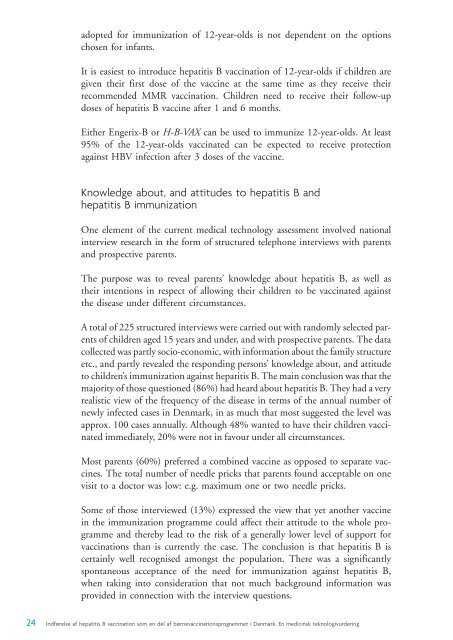Elektronisk udgave - Sundhedsstyrelsen
Elektronisk udgave - Sundhedsstyrelsen
Elektronisk udgave - Sundhedsstyrelsen
You also want an ePaper? Increase the reach of your titles
YUMPU automatically turns print PDFs into web optimized ePapers that Google loves.
adopted for immunization of 12-year-olds is not dependent on the options<br />
chosen for infants.<br />
It is easiest to introduce hepatitis B vaccination of 12-year-olds if children are<br />
given their first dose of the vaccine at the same time as they receive their<br />
recommended MMR vaccination. Children need to receive their follow-up<br />
doses of hepatitis B vaccine after 1 and 6 months.<br />
Either Engerix-B or H-B-VAX can be used to immunize 12-year-olds. At least<br />
95% of the 12-year-olds vaccinated can be expected to receive protection<br />
against HBV infection after 3 doses of the vaccine.<br />
Knowledge about, and attitudes to hepatitis B and<br />
hepatitis B immunization<br />
One element of the current medical technology assessment involved national<br />
interview research in the form of structured telephone interviews with parents<br />
and prospective parents.<br />
The purpose was to reveal parents’ knowledge about hepatitis B, as well as<br />
their intentions in respect of allowing their children to be vaccinated against<br />
the disease under different circumstances.<br />
A total of 225 structured interviews were carried out with randomly selected parents<br />
of children aged 15 years and under, and with prospective parents. The data<br />
collected was partly socio-economic, with information about the family structure<br />
etc., and partly revealed the responding persons’ knowledge about, and attitude<br />
to children’s immunization against hepatitis B. The main conclusion was that the<br />
majority of those questioned (86%) had heard about hepatitis B. They had a very<br />
realistic view of the frequency of the disease in terms of the annual number of<br />
newly infected cases in Denmark, in as much that most suggested the level was<br />
approx. 100 cases annually. Although 48% wanted to have their children vaccinated<br />
immediately, 20% were not in favour under all circumstances.<br />
Most parents (60%) preferred a combined vaccine as opposed to separate vaccines.<br />
The total number of needle pricks that parents found acceptable on one<br />
visit to a doctor was low: e.g. maximum one or two needle pricks.<br />
Some of those interviewed (13%) expressed the view that yet another vaccine<br />
in the immunization programme could affect their attitude to the whole programme<br />
and thereby lead to the risk of a generally lower level of support for<br />
vaccinations than is currently the case. The conclusion is that hepatitis B is<br />
certainly well recognised amongst the population. There was a significantly<br />
spontaneous acceptance of the need for immunization against hepatitis B,<br />
when taking into consideration that not much background information was<br />
provided in connection with the interview questions.<br />
24 Indførelse af hepatitis B vaccination som en del af børnevaccinationsprogrammet i Danmark. En medicinsk teknologivurdering

















